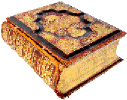After conceiving the idea of a primeval chaos, constituted of four indestructible elements of which fire was the leading one, the Oriental astrologers began to indulge in speculations relative to the agencies which were engaged in its organization. Having no knowledge of the forces inherent in nature, they imputed this work to three intelligences, which, embodying the All in All, they personified by the figure of a man with three heads, and to this trinity gave the names of Brahma, Vishnu and Siva. Such a figure, carved in stone, may be seen in the island Cave of Elephanta, near Bombay, India, and is popularly believed to represent the Creator, Preserver and Destroyer; but, in determining their true signification, we must be governed by the ancient teachings that “All things were made by one god-head with three names, and this God is all things.” Hence the conclusion is irresistible that the first person represents neither the creator nor organizer of chaos, but chaos itself; the second person, its organizer and governor; and the third person, the agent in nature which impresses all her parts with life and motion; the latter being the imaginary great soul or spirit inculcated in the Esoteric philosophy. In support of this opinion it will be found that the Egyptian Triad of Father, Son and Spirit is virtually the same we have assigned to its Oriental prototype. Thus we see that to the ancient Astrolatry Christendom is indebted for the Trinity of
“God the Father, God the Son, God the Spirit–three in one.”
But, having ascribed supreme intelligence or reason to its second person, under the name of the Logos, or Word, and designating its third person as the Holy Ghost, the ancient Triad was usually formulated as the Father, the Word and the Holy Ghost, as may be seen by reference to the text in the allegories which we find recorded in I John v. 7, which reads that “There are three that bear record in heaven, the Father, the Word and the Holy Ghost, and these three are one.”
Considered in some forms of Astrolatry as too sacred to attach a name to the triune Deity, he was called “the One,” and we find him thus designated in the 4th chapter of Revelation, where, like Zeus and Jupiter, of the Grecian and Roman mythologies, he is represented as seated above the firmament, upon a throne from which “proceeded lightnings and thunderings,” and to whom all, the subordinate divinities were made to pay homage. As the hurler of thunderbolts he was called “the Thunderer,” and as the opener of the windows of heaven, when it rained, he was designated “Jupiter Pluvius.” Such was the ancient Triad made to say of himself, in an inscription found in the ruins of the temple at Sais in Egypt, “I am all that has been, all that is, and all that shall be, and no mortal has lifted yet the veil that covers me;” and such was the Triunity referred to as the God Universe by Pliny, the Roman philosopher and naturalist, who, flourishing in the first century of the Christian era, wrote that he is “An infinite God which has never been created, and which shall never come to an end. To look for something else beyond it is useless labor for man and out of his reach. Behold that truly sacred Being, eternal and immense, which includes within itself everything; it is All in All, or rather itself is All. It is the work of nature, and itself is nature.”
Thus we see that, although inculcating homage to a multitude of subordinate divinities, the ancient Astrolatry was only an apparent Polytheism; its enlightened votaries, recognizing the dogma of the unity of God, were in reality Monotheists, paying supreme adoration to the mythical genius of the Sun, to whom we will now direct attention.
 AstroLibrary 🔎
AstroLibrary 🔎